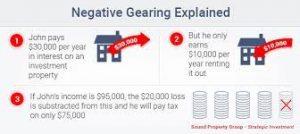
Australia Property Insight: Negative Gearing, a Tax Hack or a Trap for the Unwary?
Negative gearing describes a situation in which the expenses associated with an investment property, including mortgage loan interest and maintenance costs, are higher than the rental income generated by the property, resulting in a net loss for the owner.
Due to the structure of the income tax system in Australia, this method is most commonly associated with real estate investments. Negative gearing is a common method of reducing income tax because, unlike other countries where people are taxed directly based on their income, Australians are allowed to use property losses to offset other types of income.
For example, suppose a property owner earns $20,000 in rental income from their investment property in a year, but the expenses associated with the property total $25,000, there is a $5,000 shortfall. If the property owner has an annual income of $100,000, he can deduct the $5,000 shortfall from his total taxable income, reducing it to $95,000 and requiring him to pay less income tax.
The benefits of negative gearing depend on the financial circumstances of the property owner. For higher-income individuals, negative gearing is much more beneficial because it allows them to keep a larger portion of their income. According to an Australia Institute report, about 50% of the benefits of negative gearing accrue to the top 20% of households, while only 6% go to the bottom 20%. Negative gearing is also a short-term strategy, as the owner must cover the shortfall as long as the property is generating losses. Eventually, in order to achieve capital gains, the property value must eventually increase to the point where it can offset all of the losses.
Another factor to consider is the long-standing debate over whether negative gearing negatively affects the economy. According to a report by the Parliamentary Budget Office report, negative gearing resulted in $8.5 billion in lost tax revenue in 2021-22. If negative gearing continues to lead to a national budget deficit, the Australian government could decide to eliminate it altogether.
 Source: Sound Property Group
Source: Sound Property Group
Despite the popularity of negative gearing among real estate investors, it carries inherent risks. Incurring losses is risky, and property owners need to carefully weigh the benefits and costs before choosing negative gearing for their investment property.
Sign up to our newsletter
Sign up for our newsletter to stay in touch with global real estate news and opportunities!
By signing up, you acknowledge that you have read and agreed to our privacy policy.

